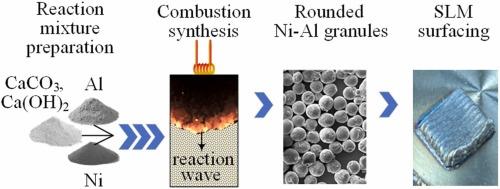燃烧合成镍铝金属间化合物圆粉
IF 6.3
2区 材料科学
Q2 CHEMISTRY, PHYSICAL
引用次数: 0
摘要
基于Ni-Al金属间化合物的球形粉末对于能源和航空航天工业中高温结构的增材制造具有重要意义。本文介绍了一种新的、节能的方法来生产精细分散(≤63 μm)的Ni-(13.6-17.0)wt圆形颗粒。% Al合金。这些合金由L1₂Ni₃Al, B2NiAl和L1₀NiAl相组成,以CaCO₃和Ca(OH)₂为改性剂,在Ni-Al反应混合物中通过燃烧合成。材料的合成和球化在反应波内同时发生。我们已经证明了颗粒的形成是Ni-Al熔体成孤立液滴的毛细融合的结果,随后在脉动热点燃烧中快速结晶。这个过程发生在大约10-100毫秒的时间内。考察了添加剂对反应温度和产物形貌的影响。与不添加添加剂的燃烧产物相比,CaCO₃和Ca(OH)₂合成的圆形颗粒流动性增强,O和N杂质浓度降低。它们的特性与球形NiAl-Cr-Co-Hf粉末相似,而球形NiAl-Cr-Co-Hf粉末是通过燃烧合成和等离子体球化两步工艺制备的。本文章由计算机程序翻译,如有差异,请以英文原文为准。

Combustion synthesis of rounded Ni-Al intermetallic powders
Spherical powders based on Ni-Al intermetallic compounds are of significant importance for the additive manufacturing of high-temperature structures used in the energy and aerospace industries. This article presents a novel, energy-efficient approach to producing finely dispersed (≤ 63 μm) rounded granules of Ni-(13.6–17.0)wt.%Al alloys. These alloys consist of L1₂Ni₃Al, B2NiAl, and L1₀NiAl phases, and are synthesized via combustion synthesis in a Ni-Al reaction mixture with CaCO₃ and Ca(OH)₂ as modifying additives. The synthesis and spheroidization of the materials occur simultaneously within the reaction wave. We have demonstrated that the formation of the granules is a consequence of the capillary fusion of the Ni-Al melts into isolated droplets, followed by rapid crystallization within the pulsating hot-spot combustion. This process occurs over a period of approximately 10–100 ms. The effect of the additives on the reaction temperature and product morphology was investigated. Compared to combustion products without additives, rounded granules synthesized with CaCO₃ and Ca(OH)₂ exhibit increased flowability and a reduced concentration of O and N impurities. Their characteristics are similar to those of spherical NiAl-Cr-Co-Hf powder, which was previously produced through a two-step process: combustion synthesis and plasma spheroidization.
求助全文
通过发布文献求助,成功后即可免费获取论文全文。
去求助
来源期刊

Journal of Alloys and Compounds
工程技术-材料科学:综合
CiteScore
11.10
自引率
14.50%
发文量
5146
审稿时长
67 days
期刊介绍:
The Journal of Alloys and Compounds is intended to serve as an international medium for the publication of work on solid materials comprising compounds as well as alloys. Its great strength lies in the diversity of discipline which it encompasses, drawing together results from materials science, solid-state chemistry and physics.
 求助内容:
求助内容: 应助结果提醒方式:
应助结果提醒方式:


